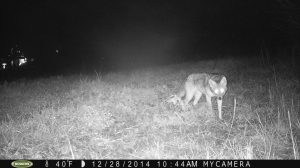This is a trail cam photo of a Coyote (Canis latrans). It was taken at my in-laws house in Memphis, TN when I was visiting with them for the holidays. They keep this camera up in an area where deer commonly cross trough their land, but this night it caught this prowler (the timing is not correct on the bottom of the photo, I believe the AM should be PM). These animals are infamous around the country because, in fairly recent history, they have expanded their range to cover most of North America and now threaten to reach into South America. The reason for this expansion can be mostly credited to human impacts on the environment. These animals are usually around 35-45 lbs. as an adult, but can exceed 50 lbs. They reproduce fairly quickly, having a 63 day gestation and 5-7 pups per litter. As with most canine species, they live 7-14 years. Coyotes typically live in small family packs, but can be solitary. They are very opportunistic feeders, usually feeding at night. Their diet can range from something as large as an adult white-tailed deer, to fruit and vegetable matter, and will rummage through our trash for scraps. They typically feed on small animals in the wild, such as rats, raccoon, lizards, birds, snakes, etc. They can also live in a variety of habitats from dry arid deserts, to swampy wetlands, and even are recorded on our barrier islands around my home in Charleston, SC.
These animals historically ranged in the western, arid regions of the country. Their numbers were kept at bay because of the larger Grey Wolf and Cougar that they shared a habitat with. Those two animals are the coyotes only known predators (besides humans). Through predation and competition these animals kept the Coyotes confined to a desert region and their population at smaller numbers. Since humans have eliminated nearly all of the Wolf species and Cougars in North America, it opened up the niche for the Coyote to thrive and expand their range. These coyotes were also moved around in early to mid 1900’s for “hound hunts” (Que Disney’s “The Fox and the Hound” or in this case “The Coyote and the Hound”). They were illegally brought into the State of South Carolina for these hunts in 1978, and now are present in all counties within the state.
There are many concerns that go along with these animals. The general attitude that most people have toward them is negative, and I have found the same negative attitude toward them among naturalist and environmental agencies here in South Carolina. The problems is that the are in nearly every environment, and their encounters with humans tend to be negative. They steal livestock from the farmers, in the residential areas they are posing a threat to humans and pets, and in their forests they are taking the deer and small game which hunters are seeking. They carry many diseases (canine distemper, rabies, hepatitis, and mange to name a few) and can spread them to humans and pets. Here in Charleston, SC we have a Threatened and Endangered Species, the Loggerhead Sea Turtle which lays its eggs along the coast of our barrier islands. The Coyotes have gotten onto those islands and are known to use the turtle eggs as a food source and wreak havoc on their nests (the same is true for some of our shorebird species that nest in the dunes along the beaches). Because of these negative interactions with humans and the environment and the fact that they have vastly extended their native range, Coyotes are now considered by most an invasive species.
Little has been (or can be) done about the growing number of Coyotes throughout the country. In South Carolina it is legal to hunt them year around on private, rural lands. There have been some efforts to trap and relocate them in some high risk areas (such as barrier islands and gated communities). Scientist have suspected that, over time, Coyote populations will stabilize and be able to coexist with the other animals in the region (but probably not humans). These Coyotes are very beautiful, resourceful animals that have gotten a negative rap for their encroachment onto human lands. It is sad that because of human interference into the natural habitats, we have made a villain out of these wonderful animals. It brings up the topic of “invasive species,” which in most cases is not the fault of the actual species, but the fault of the humans that have been altering the plant since their arrival approximately 200,000 years ago. I get mixed feelings every time I see these guys in the wild, but still like to tell their story. Hopefully we can find some way to coexist with these Coyotes and can view them as the wonderful animals they are. It has happened with there closest ancestor the Grey Wolf (Canis lupus), which was hunted to the brink of extinction in the United States because they were viewed as a nuisance (and for their pelts), but now are on a comeback and viewed as the wonderful majestic animals which they are.
Just another cool fact: If you are a dog lover, the Coyote is the second closest related species to the domesticated dog (Canis lupus familiaris) behind the Grey Wolf (which since 1993 scientist have actually found domesticated dogs and Grey Wolves are so closely related that dogs are now classified as a subspecies of the Grey Wolf).
More about Coyotes in South Carolina click Here


